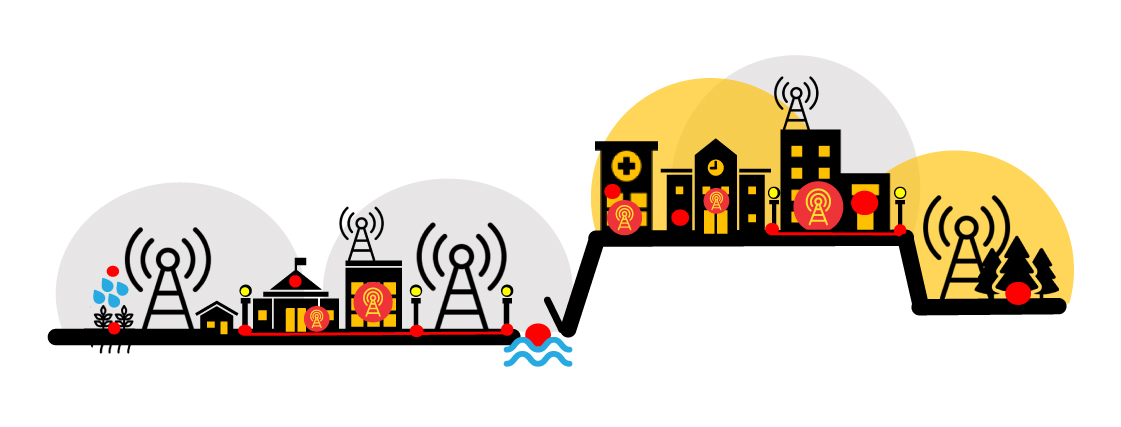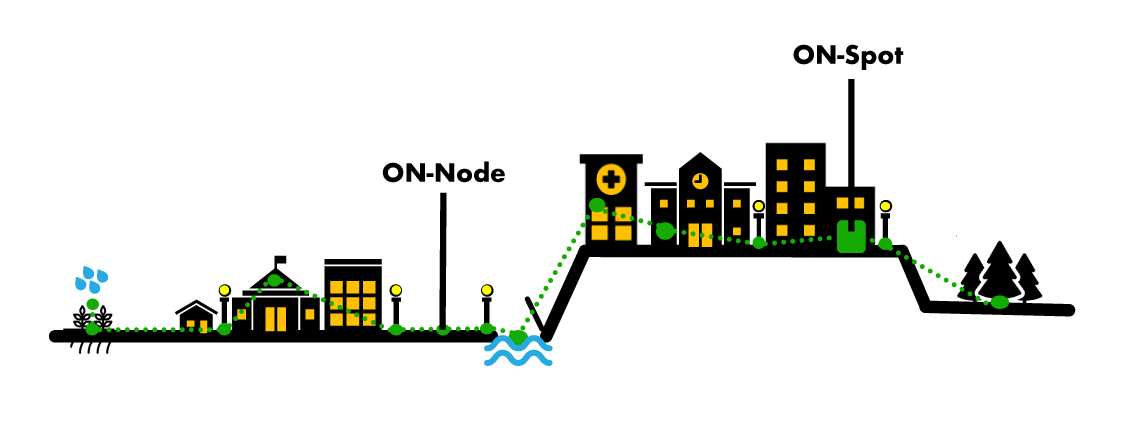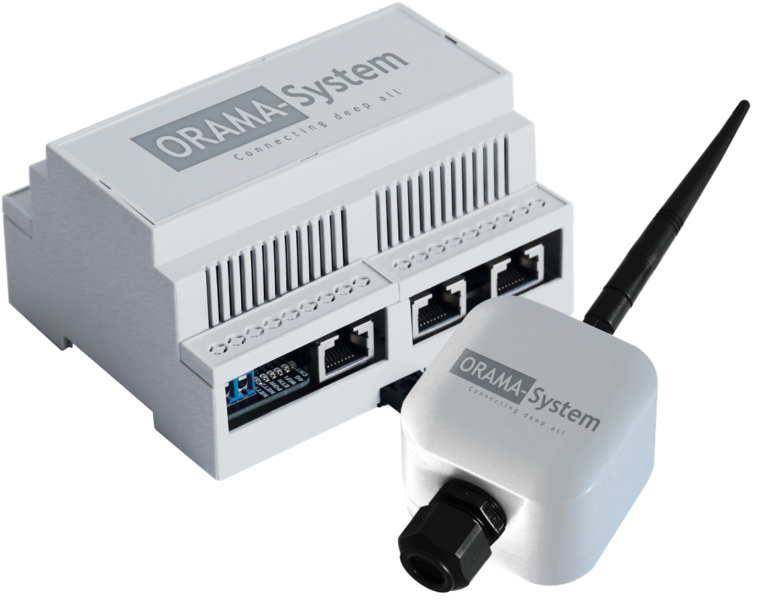How it works
Objects are
and build
the network
ORAMA-Net is a kind of LoRa Mesh network where the connected objects themselves form and maintain the network. More specifically, it is a LoRa Multi-Hop network with a very low local and energy footprint. ORAMA-Net can overcome obstacles and cover very long distances with a single micro-station, without the need for additional antennas or repeaters.


The ON-Spot micro-station
The gateway is a device that connects sensor networks to business applications. It consists of two main components: the BCU (Backend Communication Unit) and the SAA (Smart Active Antenna). The BCU is the main processing unit of the gateway, while the SAA is responsible for wireless communication. The gateway consumes less than 1W.h of power and can operate in both industrial and outdoor environments. It can even be powered by a small solar panel, making it ideal for remote locations.
LoRa Multi-Hop
Technology
entry points
ORAMA-Net combines the key features of a high-performance IoT solution: low power consumption, long range, bi-directionality, complementary interfaces, and simplicity.
communication between objects using lora
the on spot micro station is very low power
connectivity options 4G LTE CAT1 wifi ethernet
no hardware modification of the objects is required
bidirectional communication
self organizing and self healing network
For an IoT with more energy efficiency
The rapid deployment of ORAMA-Net and its very low local and energy footprint make it the ideal solution in many contexts, both on a sensitive industrial site and in the middle of an isolated forest.
no need for a lora network server
negligible radiation explosure
very favorable energy balance
subscription free no monthly fees
context independent rapid deployment
optimized and controlled return on investment
The ON-Node software stack can be installed on any LoRa object.
The ON-Spot microstation communicates with any business application
FAQ
1. Are they other wireless SENSOR networking protocols ?
Yes, they are several other WSN protocols, one part being categorized as mesh protocols with among BLE mesh, ZigBee, Thread, Wirepas or Neomesh to only cite a few, other part being categorized as LPWAN (Low Power Wide Area Network) with LoRaWAN, Sigfox, NB-IoT & LTE-M.
2. HOW IS ORAMA-NET DIFFERENT?
Although also considered as a WSN, ORAMA-Net does not fit into any of these categories but introduce a new hybrid category between short-range mesh solutions and long-range LPWAN; mesh systems hop between several nodes on short distances (few tens of meters) to reach the gateway while LPWAN systems just hop one time on a long distance (several kilometers).
ORAMA-Net hops between several nodes on long distance (up to 1km typical) using the renowned LoRa™ radio technology, with a maximum of 9 hops leading to a final range of 9km typical equivalent to LPWAN coverage.
3. SO, WHY ORAMA-NET?
ORAMA-Net ensures a reliable wide coverage equivalent to LPWAN propositions, but without paying extra complexity and energy cost on both ON-Spot micro-station side (i.e., no network backend and a typical consumption of 1W.h) and ON-Node side, which has not to repeat/to spread packets to successfully reach the gateway when located far from it (in terms of link budget).
ON is designed to deploy a private IoT network on a large-scale site, removing middlemen from the picture with minimal financial, energy and land resources
4. WHAT IS LORA MULTI-HOP?
Even if ORAMA-Net presents the same self-configuring and self-healing properties that mesh topologies above, the need for an efficient construction reconciling long range communication and favorable energy balance requires a paradigm shift.
Only a single active ON-Spot is sufficient to enroll thousands of ON-Nodes located within a radius of several kilometers, each ON-Node autonomously collaborating with others to build the optimal routes, allowing them all to converge towards the micro-station which also acts as a gateway, with a minimum of traffic therefore consumed energy. As we say: “Objects ARE and BUILD the network”.
5. WHAT IS THE DIFFERENCE BETWEEN MESH & LoRa Multi-Hop ?
2 propagation methods for mesh, normally exclusive: routing or flooding.
ORAMA-Net uses both methods, with a controlled flooding for downlink communication and balanced routing for uplink communication.
Main benefits of this strategy are that ORAMA-Net can behave like a true mesh network with a minimum of information exchanged between nodes, essential condition for building a mesh with a low data rate link of few Kilobits per second (Kbps), while most other solutions rely on 250Kbps
6. WHAT IS THE DIFFERENCE BETWEEN LORAWAN & LoRa Multi-Hop?
LoRaWAN is a single hop WSN, even if LoRa Alliance has developed the relay feature to circumvent the problem of communication with nodes located far from the gateway, in terms of link budget.
Nevertheless, LoRaWAN remains a true star network, where each node is isolated within a network of several gateways which can all receive the same message; in ORAMA-Net, each ON-Node is attached to a single ON-Spot within a network of ON-Nodes. One of the benefits of this strategy is that the relay feature is native to LoRa Multi-Hop, therefore not limited to a dedicated device but part of the DNA of each ON-Node whatever the function of the attached sensor or actuator; a simple temperature sensor can act as a relay for a pressure sensor. Another benefit is that ORAMA-Net does not require a Network Server, reducing the complexity and costs of deployment; ON-Spot gateway connects directly to the user Application Server without intermediary backend service to maintain and to pay for.
7. WHAT IS THE SCALABILITY OF ORAMA-NET?
Thanks to the very low bandwidth used by system messaging, an ORAMA-Net cluster can reach up to 64K ON-Nodes. For a 20% network load and with full aggregation, ON-Spot gateway can receive up to 192,000 messages of 50 payload bytes per day; this is one message per ON-Node each 8 hours for a cluster of 64K ON-Nodes, and each 7.5 minutes for 1K ON-Nodes. Scalability also relies on security: ORAMA-Net is private and protected by a unique 256-bit PNK (Private Network Key) assigned to a registered owner; knowing since, several clusters belonging to the same owner can be distributed worldwide.
8. WHAT IMPACT ON CONSUMPTION ?
A large majority of solutions systematically focus on the individual consumption of the connected object, which is undoubtedly important, but without mentioning that of the infrastructure made up of gateways or base stations on the one hand, and network servers on the other. ORAMA-Net thinks globally and considers all consumptions to make it the best system on the market in terms of impact and carbon footprint; not only do connected objects consume little, but the infrastructure necessary for operation is deliberately frugal. Like mesh, LoRa Multi-Hop system must manage the additional consumption linked to the relay activity of the nodes close to the gateway; this is the funneling effect and ORAMA-Net uses message aggregation to limit the impact of this activity (typical 30% reduction in autonomy for rank 1 nodes). The balance is reversed in an LPWAN system where these are the distant nodes which show battery depletion most quickly; given that there are potentially more distant nodes than close nodes to the gateway, there will therefore be more batteries to replace in an LPWAN than in an LoRa Multi-Hop.
9. HOW TO jOIN a NODE without wakeup scheduling ?
With LPWAN solutions, it is not possible to join a node at any time; you must first wait for the node to connect to the server to be able to send it an instruction. Unless you schedule dummy messages sending regularly, which will dramatically increase device consumption, descending commands will expose high latencies and the system will not be responsive. In ORAMA-Net, the nodes are cyclically listening on a dedicated channel, using our ultra-low power WOR (Wake On Radio) process (25µA.h as typical floor consumption), and the result is that the latency between ON-Spot and any ON-Node in the network is less than or equal to 20 seconds.
10. WHY IS THE ORAMA-NET GATEWAY SPLIT INTO 2 PARTS?
To our knowledge, there is no solution of this type on the market, and this is another originality of ORAMA-Net; so, the question is why such a choice?
The 1st reason relates to security; the best location from the point of view of radio coverage is rarely the best location for protecting the device against theft, damage and corruption. With ON-Spot, only the tiny antenna part of the gateway is exposed and accessible from outdoor.
The 2nd reason relates to certain use cases where it is vital to reach the objects to be connected in depth; with ON-Spot, via a simple standard ethernet cable, it is possible to separate the gateway controller from the active antenna by more than 300 meters.

Evaluate or test the potential of the solution
Evaluate ORAMA-Net through a tailored pilot project or the demo kit